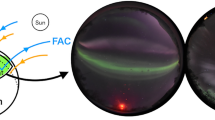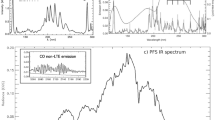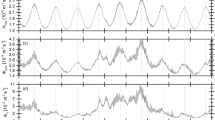Abstract
The aim of this work is to study the relationship between the pre-earthquake emissions of radon and ULF/ELF (1–30 Hz) atmospheric electromagnetic radiation. The problem is considered on the example of the 2011 Tohoku earthquake. Radon, ionizing air, creates ions—centers of condensation of water vapor. As a result of condensation, heat is generated. It results in growth of air temperature and decrease in its humidity. This phenomenon serves as an indicator of air ionization. We used data from 20 Japan Meteorological Agency (JMA) weather stations located on Honshu Island to estimate any changes in temperature and humidity over ± 20 days from the date of the main shock. At the same time, we monitored the intensity and location of the source of ULF/ELF radiation using three induction magnetometers belonging to Chubu University. We compared the times and locations of observed signs of ionization and electromagnetic radiation to find out their relationship. It turned out that they are independent, since their dates and localizations do not match. In addition, we found intense ionization of the air after March 11 over a large area of Honshu Island, caused by radiative radiation from the nuclear disaster at the Fukushima Daiichi nuclear power plant. However, this phenomenon did not cause low-frequency atmospheric electromagnetic radiation either. These suggest that there is no direct relationship between air ionization and ULF/ELF radiation. This is true at least for this case, given the island nature of the land and oceanic EQs.




source of this radiation is located somewhere near the position of the Japanese Trench (the latter is shown by a thick gray line). The hexagon stars display epicenter positions of EQs with Mw > 7





Similar content being viewed by others
References
Aliano C, Corrado R, Filizzola C, Genzano N, Pergola N, Tramutoli V (2008) Robust TIR satellite techniques for monitoring earthquake active regions: limits, main achievements and perspectives. Ann Geophys 51(1):303–318
Blackett M, Wooster MJ, Malamud BD (2011) Exploring land surface temperature earthquake precursors: a focus on the Gujarat (India) earthquake of 2001. Geophys Res Lett 38:L15303
Dunajecka M, Pulinets SA (2005) Atmospheric and thermal anomalies observed around the time of strong earthquakes in Mexico. Atmosfera 18(4):233–247
Fowler RA, Kotick BJ, Elliot RD (1967) Polarization analysis of natural and artificially induced geomagnetic micropulsations. J Geophys Res 72:2871–2875
Giuliani GG, Giuliani R, Totani G, Eusani G, Totani F (2009) Radon observations by gamma detectors PM-4 and PM-2 during the seismic period (January-April 2009) in L’Aquila Basin, Abstr. AGU Fall Meeting, December 14–18, 2009, San-Francisco, vol. 1: 03, id #U14A-03
Gorny V.I., A.G.Salman, A.A.Tronin, B.V.Shilin (1988) Terrestrial outgoing infrared radiation as an indicator of seismic activity, Proceedings of the Academy of Sciences of the USSR, 1988, vol.301, No.1, pp.67–69
Hata M, Ohta K, Izutsu J et al (2010) Development of ULF band receiver for detecting electromagnetic-wave precursor of earthquakes. J Atmos Electr 30(1):13–36
Hayakawa M (2015) Earthquake prediction with radio techniques. John Wiley and Sons, Singapore
Hayakawa M, Kasahara Y, Nakamura T et al (2011) Atmospheric gravity waves as a possible candidate for seismo-ionospheric perturbations. J Atmosc Electr 31(2):129–140
Hayakawa M, Schekotov A, Izutsu J, Nickolaenko AP (2019) Seismogenic effects in ULF/ELF/VLF electromagnetic waves. International Journal of Electronics and Applied Research (IJEAR), vol. 6, issue 2, Dec 2019 Online (http://eses.net.in/online_journal.html) ISSN 2395–0064
Molchanov O, Hayakawa M (2008) Seismo-electromagnetics and related phenomena: history and latest results. Terrapub, Tokyo
Molchanov O, Fedorov E, Schekotov A, Gordeev E, Chebrov V et al (2004) Lithosphere-atmosphere-ionosphere coupling as governing mechanism for preseismic short-term events in atmosphere and ionosphere. Nat Hazards Earth Syst Sci 4(5/6):757–767
Ohta K, Izutsu J, Schekotov A, Hayakawa M (2013) The ULF/ELF electromagnetic radiation before the 11 March 2011 Japanese earthquake. Radio Sci 48:589–596. https://doi.org/10.1002/rds.20064
Omori Y, Yasuoka Y, Nagahama, et al (2007) Anomalous radon emanation linked to preseismic electromagnetic phenomena. Nat Hazards Earth Syst Sci. https://doi.org/10.5194/nhess-7-629-2007
Ouzounov D, Sergey P, Katsumi H, Patrick T (2008) Pre-earthquake processes: a multidisciplinary approach to earthquake prediction studies, John Wiley and Sons, ISBN: 978–1–119–15693–2 American Geophysical Union 384 Pages
Ouzounov D, Pulinets S, Romanov A et al (2011) Atmosphere-ionosphere response to the M9 Tohoku earthquake revealed by multi-instrument space-borne and ground observations: Preliminary results. Earthq Sci 24:557–564. https://doi.org/10.1007/s11589-011-0817-z
Pulinets S, Ouzounov D (2011) Lithosphere-atmosphere-ionosphere coupling (LAIC) model – a unified concept for earthquake precursors validation. J Asian Earth Sci 41(4–5):371–382. https://doi.org/10.1016/j.jseaes.2010.03.005
Pulinets SA, Ouzounov D, Karelin AV, Boyarchuk KA, Pokhmelnykh LA (2006) The physical nature of thermal anomalies observed before strong earthquakes. Phys Chem Earth 31:143–153. https://doi.org/10.1016/j.pce.2006.02.042
Pulinets SA, Ouzounov DP, Karelin AV, Davidenko DV (2015) Physical bases of the generation of short-term earthquake precursors: a complex model of ionization-induced geophysical processes in the lithosphere-atmosphere-ionosphere-magnetosphere system. Geomagn Aeron 55:521–538. https://doi.org/10.1134/S0016793215040131
Qiang ZJXDXu, Dian CG (1991) Thermal infrared anomaly precursor of impending arthquakes, Chinese Sci. Bull 36:319–323
Qin K, Wu LX, De Santis A, Meng J, Ma WY, Cianchini G (2012) Quasi-synchronous multi-parameter anomalies associated with the 2010–2011 New Zealand earthquake sequence. Nat Hazards Earth Syst Sci 12:1059–1072
Schekotov A, Hayakawa M (2015) Seismo-meteo-electromagnetic phenomena observed during a 5-year interval around the 2011 Tohoku earthquake. Phys Chem Earth 85–86:167–173. https://doi.org/10.1016/j.pce.2015.01.010
Schekotov A, Hayakawa M (2017) ULF/ELF Electromagnetic phenomena for short-term earthquake prediction. LAP LAMBERT Academic Publishing, ISBN 978-3-330-06286-3 Schekotov A, Chebrov D, Hayakawa M, Belyev G, Berseneva N (2020) Short-term earthquake prediction in Kamchatka using low-frequency magnetic fields. Nat Hazards 100:735–755. https://doi.org/10.1007/s11069-019-03839-2
Schekotov AY, Molchanov OA, Hayakawa M et al (2007) ULF/ELF magnetic field variations from atmosphere induced by seismicity. Radio Sci. https://doi.org/10.1029/2005RS003441
Schekotov A, Fedorov E, Molchanov O, Hayakawa M (2013) Low frequency electromagnetic precursors as a prospect for earthquake prediction, "Earthquake Prediction Studies: Seismo-Electromagnetics", ed. by Hayakawa M., TERRAPUB, pp 81–99
Tramutoli V, Bello GD, Pergola N, Piscitelli S (2001) Robust satellite techniques for remote sensing of seismically active areas. Ann Geofis 44(2):295–312
Tronin AA (1996) Satellite thermal survey-a new tool for the study of seismoactive regions. Int J Remote Sens 41:1439–1455
Yang SS, Hayakawa M (2020) Gravity wave activity in the stratosphere before the 2011 Tohoku earthquake as the mechanism of lithosphere-atmosphere-ionosphere coupling. Entropy 22(1):110. https://doi.org/10.3390/e22010110
Yoshikane T, Yoshimura K, Chang E et al (2016) Long-distance transport of radioactive plume by nocturnal local winds. Sci Rep 6:36584. https://doi.org/10.1038/srep36584
Acknowledgements
We are grateful to Chubu University group for providing us with the data from induction magnetometers. We thank Japan Meteorological Agency for weather parameters data. The authors thank the World Geomagnetism Data Center for proving Kp index data and United States Geological Survey for providing data on EQ parameters.
Funding
Any commercial or financial relationships are absent that could be construed as a potential conflict of interest
Author information
Authors and Affiliations
Corresponding author
Ethics declarations
Conflict of interest
The authors declare that they have no conflict of interest
Additional information
Publisher's Note
Springer Nature remains neutral with regard to jurisdictional claims in published maps and institutional affiliations.
Rights and permissions
About this article
Cite this article
Schekotov, A., Hayakawa, M. & Potirakis, S.M. Does air ionization by radon cause low-frequency atmospheric electromagnetic earthquake precursors?. Nat Hazards 106, 701–714 (2021). https://doi.org/10.1007/s11069-020-04487-7
Received:
Accepted:
Published:
Issue Date:
DOI: https://doi.org/10.1007/s11069-020-04487-7




